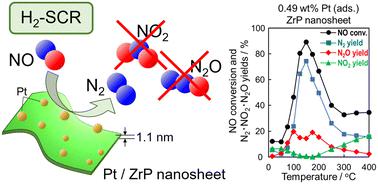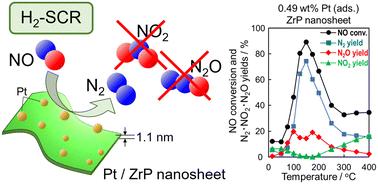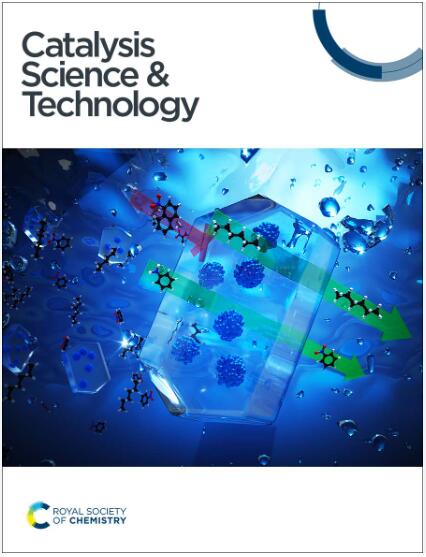磷酸铂/锆纳米片在过量氧气中利用 H2 选择性催化还原氮氧化物
IF 4.4
3区 化学
Q2 CHEMISTRY, PHYSICAL
引用次数: 0
摘要
过去几十年来,二维纳米材料因其固有的各向异性晶体结构和大比表面积而在催化剂材料化学领域备受关注。特别是过渡金属磷酸(TMP)纳米片,作为铂族金属(PGM)催化剂的支撑材料,在通过选择性催化还原(SCR)转化氮氧化物方面具有巨大潜力。之前的一份报告认为,Rh/ZrP2O7 催化剂在与 C3H6 的 SCR 反应中表现出良好的催化活性,这是由于 Rh-O-P 链接的强锚定效应和 PO4 的亲电性超越了 RhOx 纳米颗粒的烧结,促进了 Rh 物种的快速氧化还原反应。在本研究中,我们利用支撑在单层磷酸锆(ZrP)纳米片上的铂纳米粒子,证明了通过 H2 SCR(H2-SCR)转化 NO 的催化活性。单层磷酸锆纳米片是通过在 0.25 M 乙胺溶液(50% 乙醇水溶液)中分层α-磷酸锆(α-Zr(HPO4)2-H2O)而获得的。ZrP 纳米片的晶体结构在 Zr(HPO4)2 转化为 ZrP2O7 后,热稳定性可达 500 °C,这一温度足以用作 H2-SCR 催化剂(RT-400 °C)。在 150 °C、NO(200 ppm)-H2(5000 ppm)-O2(10%)-He(平衡)气氛下,0.49 wt% 的 Pt/ZrP 纳米片显示出较高的 NO 转化率(89%)和适度的 N2 选择性(83%)。当 H2-SCR 测试重复进行三个周期时,Pt/ZrP 纳米片催化剂仍能保持其催化活性。对铂的粒度(HAADF-STEM)和电子状态(XPS)的进一步研究表明,ZrP 纳米片结构上高负载量的小铂颗粒(直径:1 nm)是实现高 NO 转化率和低 NOx 副产物产量的关键。本文章由计算机程序翻译,如有差异,请以英文原文为准。


Selective catalytic NOx reduction by H2 in excess O2 over Pt/zirconium phosphate nanosheets†
Two-dimensional nanomaterials have attracted attention over the past several decades in the field of catalyst materials chemistry because of their intrinsic anisotropic crystal structure and large specific surface area. In particular, transition-metal phosphate (TMP) nanosheets have great potential as supporting materials for platinum-group metal (PGM) catalysts for the conversion of NO via selective catalytic reduction (SCR). A previous report concluded that the Rh/ZrP2O7 catalyst showed good catalytic activity in the SCR reaction with C3H6 due to the strong anchoring effect of Rh–O–P linkages and the electrophilic nature of PO4, which surpasses sintering of RhOx nanoparticles and promotes the rapid redox reactions of Rh species. In the present study, we demonstrated the catalytic activity toward NO conversion via SCR with H2 (H2-SCR) using Pt nanoparticles supported on a monolayer zirconium phosphate (ZrP) nanosheet. The monolayer ZrP nanosheet was obtained by delaminating layered alpha-zirconium phosphate (α-Zr(HPO4)2·H2O) in 0.25 M ethylamine solution (50% ethanol in water). The crystal structure of the ZrP nanosheet was thermally stable upto 500 °C after the Zr(HPO4)2 was transformed into ZrP2O7, which was a sufficiently high temperature for operation as an H2-SCR catalyst (RT-400 °C). The 0.49 wt% Pt/ZrP nanosheet showed high NO conversion (89%) and moderate N2 selectivity (83%) at 150 °C under a NO (200 ppm)–H2 (5000 ppm)–O2 (10%)–He (balance) atmosphere. The Pt/ZrP nanosheet catalyst maintained its catalytic activity when the H2-SCR test was repeated for three cycles. Further investigation of the particle size (HAADF-STEM) and electronic state (XPS) of the Pt suggested that the small Pt particles (diameter: ∼1 nm) with a high loading amount on the ZrP nanosheet structure were key to achieving a high NO conversion rate with a low yield of NOx byproducts.
求助全文
通过发布文献求助,成功后即可免费获取论文全文。
去求助
来源期刊

Catalysis Science & Technology
CHEMISTRY, PHYSICAL-
CiteScore
8.70
自引率
6.00%
发文量
587
审稿时长
1.5 months
期刊介绍:
A multidisciplinary journal focusing on cutting edge research across all fundamental science and technological aspects of catalysis.
Editor-in-chief: Bert Weckhuysen
Impact factor: 5.0
Time to first decision (peer reviewed only): 31 days
 求助内容:
求助内容: 应助结果提醒方式:
应助结果提醒方式:


